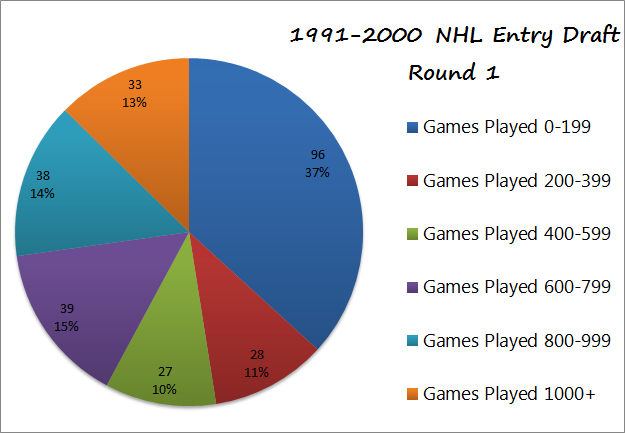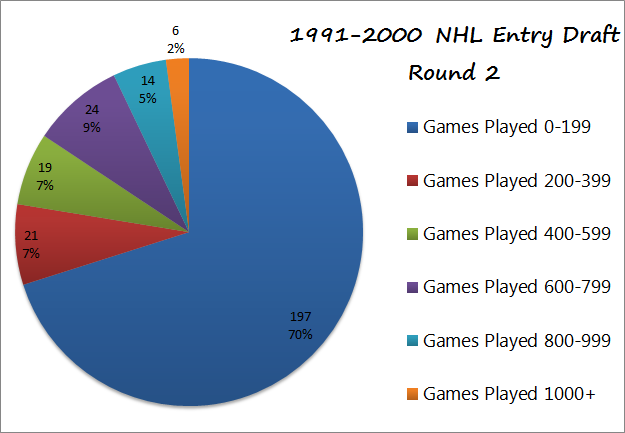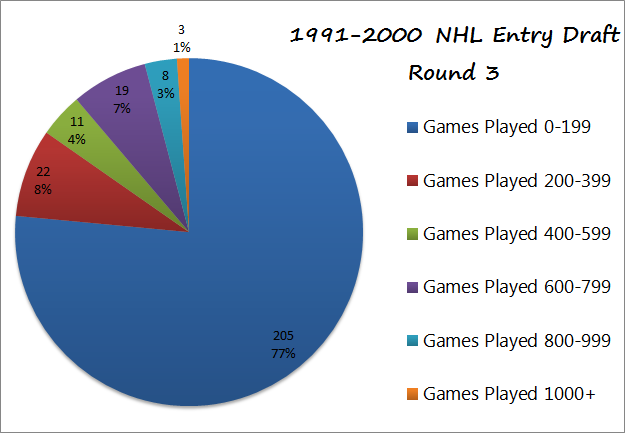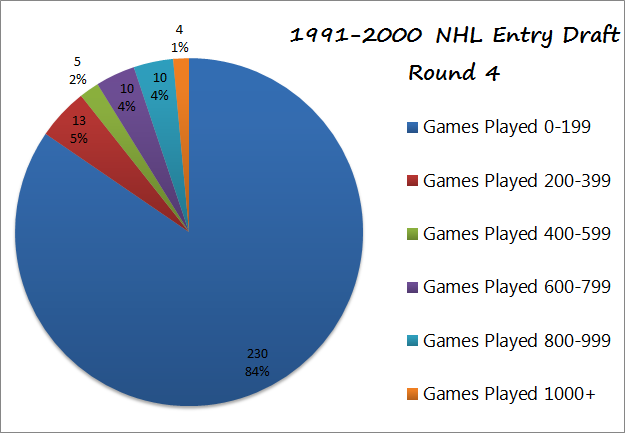Questions
Every year over 200 players are selected at the NHL Entry Draft but how many actually make it into the NHL? Of those that make it into the NHL how many have long lasting careers? What is the chance of picking an NHL caliber player in the first round compared to other rounds? All of these questions and more will be answered in this article and in the articles to follow dedicated to analyzing the mystery that is the NHL Entry Draft.
Criteria
In order to analyze the NHL Entry Draft we have to make a few clarifications. First, the definition of a career NHL player can be a debatable topic so to keep things simple we will use total games played on an interval scale. Second, only NHL regular season games will be used, no pre-season or playoff games. Third, variables including injuries, suspensions, playing in other leagues and in some cases, death will be disregarded. Fourth, this is an analysis of players taken in the draft only, sorry to disappoint the Ed Belfour and Martin St. Louis fans.
A 10-year sample size from 1991-2000 NHL Entry Drafts will be the starting template. It is easier to create baseline statistics with older and more established players. Since the 2001 draft, only eight players drafted have played over 700 NHL games and only two have played over 800, one being Ilya Kovalchuk. Hockey Hall of Famer Pavel Bure only played 702 games in the NHL but that still exceeds such superstars as Sidney Crosby, Alexander Ovechkin and Jonathan Toews as of 2014. Once these statistics have been interpreted we can use that information and tweak it to better suit more recent drafts in future articles.
Formula
- The 1991-2000 drafts will be broken down into 200 game intervals beginning with 0-199 and maxing out at 1000+.
- Each chart shows the amount of players that make up each 200 game interval as well as their percentage in each round.
- Rounds 1-4 are broken down individually over the ten year period.
- Round 5+ is a collection of all the later rounds over the ten year period.




More Information
- A total of 2,644 players were drafted between 1991 and 2000.
- As of 2014, only 520 players (19.7%) have played at least 200 games.
- 165 of 261 players taken in the first round have played at least 200 games. (63.2%)
- 189 of 821 players taken in rounds 2-4 have played at least 200 games. (23.0%)
- 166 of 1,564 players taken from round 5 onward have played at least 200 games. (10.6%)
From the data it is clear that first round draft picks are more likely to make the jump to NHL. Notice that first round players are almost twice as likely to play over 200 games when compared to second round players. Also, first round draft picks are more likely to have longer lasting NHL careers. Currently there are 127 players from 1991-2000 drafts still playing in the NHL. 49 of those players were drafted in the first round or 38.6%. Because current players from those draft years are still in the NHL the data above will change over time. Still these changes will be minimal as all players from those years are now over the age of 31 and of the remaining drafts picks only four have played under 200 games meaning these changes will be minimal.
Key Differences Today
Finally, when looking at these draft statistics we must consider the amount of players selected. From 1991-2000 the average amount of selections was 264 with the highest being 293. Since the 2005 lockout, the standard NHL Entry Draft has been 211 selections which is far less than it was during the 90’s. Also after the lockout the NHL has limited the draft to consist of only 7 rounds with each round having an equal number of picks. Before the 2005 lockout,the draft had as many as 12 rounds and would differ on the amount of selections per round sometimes by as many as ten. In some cases the first round would have 26 picks while another round would have 36. Because of these differences we can make a few assumptions about today’s NHL Entry Draft.
- After the 2005 lockout, 1st round picks are now less likely to succeed since more 1st round picks are made today.
- After the 2005 lockout, late picks (5th round and on) are now more likely to succeed since the total amount of picks is much smaller.
These assumptions will be discussed in future articles.